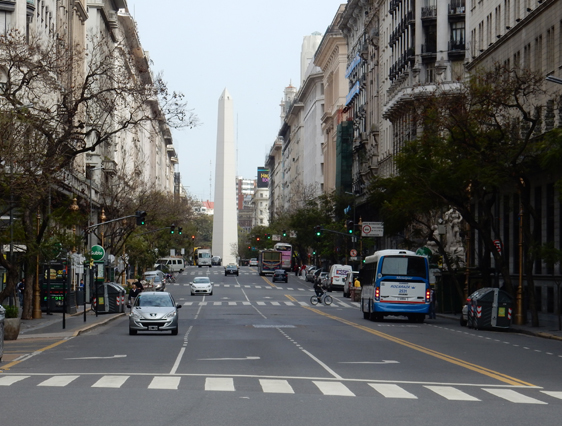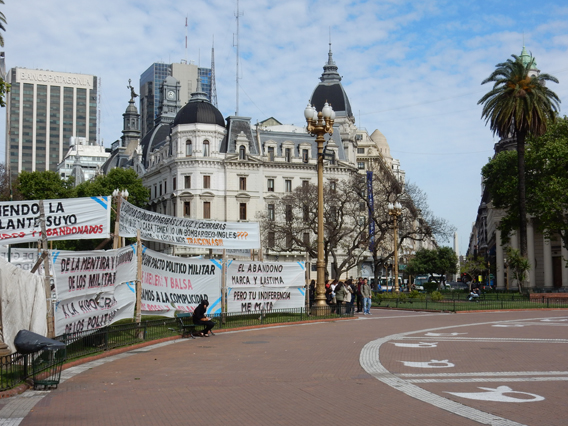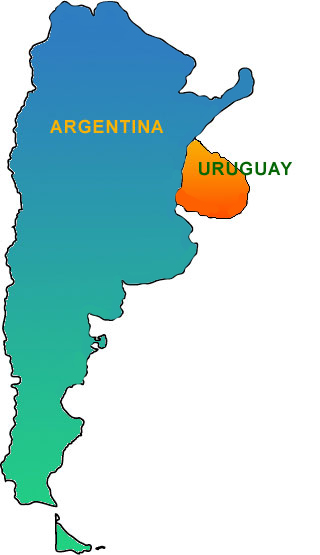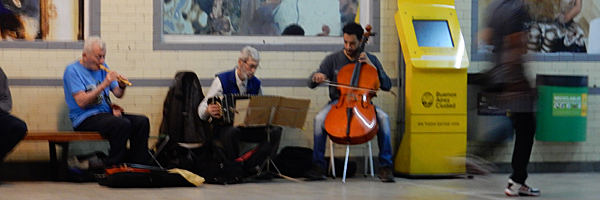The Argentine Peso
Got a full night of sleep last night, but still not completely adjusted to Argentine time. I woke up extremely early and took a walk around my barrio of San Telmo, but nothing was open yet, so I had to do without coffee. Finally around 8am the Café Plaza Dorrego opened up and I went in for a café con leche.
The Café Plaza Dorrego is one of the most famous cafés in Buenos Aires and was a frequent haunt of Jorge Luis Borges, Ernesto Sábato, and other great Argentine writers and artists. The atmosphere is dark and cozy, with small wooden tables and chairs that suggest a good place to sit and read all day long. Every surface of the tables, as well as that of the wood paneling on the walls, is inscribed with the names of hundreds of people who have visited this café over the years.
After breakfast, I went back to my apartment to prepare for a day of exploring the city. I worked out a vague itinerary, taking care to remain flexible. It was my first full day in Buenos Aires, so I wanted to freely roam about the city, letting my whims carry me down a side street or into an unexpected plaza.
Before I could begin my explorations though, I needed to change some dollars into pesos. I had changed a little bit upon my arrival at the airport, and this was my first indication that money in Argentina is complicated. The process at the airport involved waiting in a long line, filling out some paperwork, and showing my passport and boarding pass. Finally I was able to get some Argentine pesos at the official rate of about nine pesos to a dollar.
So this morning I ventured out into the Mercado Azul, the Blue Market. This is more of a concept than an actual place, but it is most apparent in the Calle Florida, a small pedestrian street just off of the Plaza de Mayo. After a short and pleasant walk through the early morning streets of San Telmo, I came to the very center of the city. Plaza de Mayo is the heart and soul of Buenos Aires and actually of all of Argentina, a civic and social gathering spot that has been a witness to much of Argentine history.

From the Plaza de Mayo, looking up the Avenida Presidente Roque Sáenz Peña, which leads to Calle Florida
When I got to Calle Florida, it was easy to find a money changer. The touts stood out in the street, calling out "Cambio, cambio, casa de cambio!" I was amazed at how open they were, conducting this illegal activity in broad daylight. I went with the first tout I saw, wanting to get this over with as soon as possible. It felt rather dirty and unseemly, but the difference in the rates given is phenomenal. They generally pay about 15 pesos to the dollar, slightly more if you have larger bills like 50s or 100s. This is 67% more than the official rate, enough to significantly reduce the costs of this city in a noticeable way.
I followed the tout down into a basement in a shopping mall, feeling very uneasy and more and more dirty. Then we entered a small storefront that looked much like a bank, with a teller's window next to plush chairs for visitors. I handed over my dollars and the teller did a calculation. He then pushed a handful of 100-peso notes into a money-counting machine, which counted out the exact number of bills. The whole process took about a minute, with no paperwork or complications. I suddenly felt like I had a wallet full of free money.
Later that night I had a great conversation with my neighbor Maria, who explained to me the reasons for this odd Mercado Azul, how it is illegal but widely tolerated, and how it is caused by short-sighted economic policy that has been going on for years. Argentine citizens are extremely limited in their ability to buy dollars, and to do so legally, they must show documentation that demonstrates the source of their income. There is a widespread "under the table" labor market here, so it is not always easy to prove the origins of one's income, thus spawning strong demand for dollars that can be obtained by means other than the official channels.

Plaza de Mayo, with protest banners from veterans of the Malvinas War
I went back to the Plaza de Mayo and stood quietly to soak in the political ghosts that inhabit this square. From the events of 1810 that culminated in Argentina's independence from Spain, to the more recent demonstrations of the Madres de la Plaza de Mayo, this civic space is the place where Argentines have been going to express their hopes, dreams, and desires for more than two centuries. In front of the plaza is the Casa Rosada, the "Pink House," which is the presidential palace and seat of the executive branch of the Argentine government.
In the center of the plaza is the Pirámide de Mayo, a large statue adorned with allegories of Industry, Commerce, The Sciences and The Arts, and crowned by an allegory of Liberty, all the work of French sculptor Joseph Dubourdieu. It was constructed in 1811 to celebrate the first anniversary of the May Revolution that led to independence. In another corner of the plaza is a monument to veterans killed in the Guerra del Pacifico de Sur, also known as the Malvinas War or the Falklands War.
From the Plaza de Mayo, I walked back to my apartment, thinking it was best to drop off some of the large quantity of cash I was carrying with me. I took a different route through San Telmo and stumbled upon an unexpected surprise: the Paseo de la Historieta.
| Next up: Paseo de la Historieta
|


© 2016 Michael Hanrahan